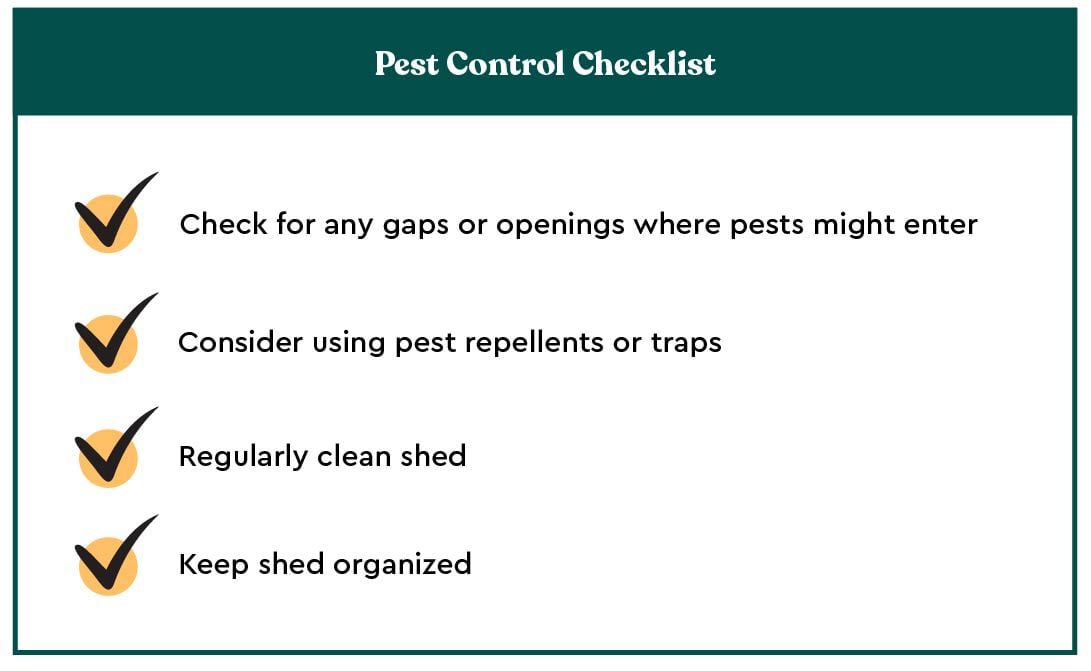
How to Keep Mice and Other Pests out of a Storage Shed
How do you keep mice and pests out of your shed? It’s a question a lot of homeowners end up asking. You might start noticing things like droppings in the corner, chewed-up items or worse. Sheds are prime real estate for pests like mice, wasps, spiders and all kinds of bugs. Why would a mouse (or pest) want to hang out in your shed, though? Well, sheds are usually quiet, sheltered and often filled with things that make perfect nesting material.
Unfortunately, even one unwanted guest can lead to bigger problems. This can mean damage to your tools or storage bins, contamination of pet food or garden supplies and potential safety hazards. If you're trying to figure out how to keep mice out of your shed or how to stop other pests from sneaking in, we’re here to help!
Let’s break down common pests and what you can do to keep pests out of your shed for good.
Common Shed Invaders: Know Your Enemy
Let’s start by talking about common pests you might find in your shed.
Rodents: Small Size, Big Headache
Mice and rats are very common, and can be very destructive shed invaders. They’re drawn to quiet, undisturbed spaces where they can build nests and find food. Once inside, they’ll chew through wires, insulation and even storage bins, leaving behind a mess (and sometimes a smell) that’s tough to ignore. If you’ve got a garden shed with a few gaps or unsealed corners, it’s basically an open invitation for rodents.
Insects: The Silent Squatters
Spiders, ants, cockroaches and silverfish are all known for sneaking into storage sheds unnoticed until they become a problem. These bugs love dark environments and often hide in cardboard boxes, cluttered corners or under shelving. Some, like silverfish, feed on paper, fabric and more. Others, like cockroaches, are just gross and hard to get rid of once they’re settled in.
Termites: The Silent Destroyers
While mice and insects might be the most obvious pests to worry about, termites can be an even more insidious problem. These tiny creatures can cause significant structural damage to wooden sheds by slowly eating away at the wood, often without you even noticing until it's too late. Termites are drawn to wood that's damp or decaying, which makes untreated or older wooden sheds particularly vulnerable. They prefer dark, hidden areas like the corners and floorboards, and their presence often goes undetected until the damage becomes apparent.
Wasps and Wildlife: Unwanted Guests
Wasps are notorious for building nests in eaves, rafters and quiet rooflines—making your shed a prime target if you’re not checking it regularly. And while they don’t damage storage items the way rodents do, they can pose a serious safety risk, especially if you stumble onto a nest unexpectedly.
Other small animals like chipmunks, squirrels or even snakes can sneak into sheds, especially if the area around the shed is overgrown or cluttered.
None of these pests are fun to host in your sheds. So, it’s important to understand how they get in.
How Mice and Pests Get into Sheds

You’d be surprised how little it takes for pests to find their way into your shed. Did you know that mice can squeeze through tiny holes? Gross! They’re not the only ones, either. Gaps around door frames or cracks in the foundation are basically welcome signs for anything small enough to scurry or crawl.
Cluttered or neglected sheds are even more inviting. If you’ve got stacks of cardboard boxes, loose fabric or bags of seed sitting on the floor, you’re creating the perfect nesting conditions for rodents and bugs alike. Add in a shed that’s close to tall grass, trees or overgrown landscaping, and you’ve just made it even easier for pests to move in.
The key is identifying these weak spots in your shed before they do. A quick inspection and a few simple changes can make a huge difference in keeping mice and other pests out of your shed for good.
How to Keep Mice out of Your Shed (And Other Rodents, Too)
Okay, so the big questions are, how do you keep mice and rodents out of your shed? How do you keep bugs out of your shed?
1. Maintain the Area Around Your Shed
Keep the area around your shed clean and trimmed. Wood piles, overgrown shrubs and tall grass are perfect places for rodents to nest. So, regularly mow and clear the area around your shed to give them fewer places to lay low.
2. Use Deterrents
Go the extra mile and use natural deterrents like peppermint oil (a great mouse repellent), vinegar, ultrasonic devices or well-placed traps to discourage rodents from settling in.
3. Check Doors and Vents
Make sure your shed doors and vents are tightly sealed by adding weather stripping and a sturdy door sweep to block drafts and tiny intruders.
4. Store Food Securely
Honestly, it’s probably best to not store food in a shed. However, if you have to, keep in mind that mice have an excellent sense of smell. Safely storing things like pet food, birdseed and garden supplies can be hard to do in a shed. If you need to, opt for airtight containers to keep them from attracting rodents.
5. Seal Gaps and Holes
Mice can squeeze through teeny tiny openings, so inspect your shed carefully. Check around the base, corners and roofline for cracks and gaps. Use a combo of caulk and steel wool (mice hate chewing through steel wool).
6. Declutter and Elevate
Rodents love to hide in clutter. So, keep your shed clean and think about elevating stored items off the floor, so there are fewer places for mice to nest.
How to Keep Bugs out of a Shed
Opening your shed and seeing bugs is never a great feeling. However, there are a few things you can do that can help you keep insects out:
1. Create a Barrier Around the Shed
Consider using diatomaceous earth or applying an insect barrier around your shed’s base. It can act as a first line of defense before bugs ever reach the inside of your shed.
2. Be Careful About Shed Entry Points
Be sure to check for gaps in vents, siding and corners of your shed. If you find any, seal them up and add mesh screening to block tiny insects from sneaking in unnoticed.
3. Avoid Cardboard Storage
Cardboard is a magnet for pests like silverfish and roaches. Instead, use plastic bins with tight lids. They’re more bug-resistant, easy to clean and stack neatly.
4. Keep the Perimeter Clean
Like with mice, you need to keep the area around your shed well kept. So, trim grass, weeds and overgrown plants around your shed. A clear perimeter leaves fewer places for insects to hide and makes your shed less appealing to them overall.
Now that we have a better understanding of pests and how to prevent them based on the pest type, let’s explore pest prevention based on the shed type.
Pest-Proofing Tips for Different Types of Sheds

It’s no secret that different shed types have different strengths and weaknesses. When it comes to keeping pests out, the material your shed is made from plays a big role. Plastic and resin sheds, like those from Keter, have a natural advantage. They’re weather-resistant so they do not warp, rot or crack, which means fewer entry points for rodents and bugs. That said, it’s still smart to check around the doors and vents. It’s also important to maintain the area around your shed, too.
Wooden sheds tend to need a bit more maintenance. Over time, wood can crack, shift or rot, leaving small gaps that are perfect for pests to sneak through. Keep an eye on those trouble spots, especially along the base and corners, and reseal them as needed. Make repairs ASAP to avoid pest problems.
Metal sheds might seem bulletproof, but they’re not pest-proof. Rust spots and sharp-edged holes can develop over time, especially in high-humidity areas. Make a habit of inspecting for corrosion or openings that critters could squeeze through. A quick patch-up job can save you from a bigger infestation down the line.
Seasonal Shed Maintenance Checklist to Keep Pests out
Keeping pests out of your shed isn’t just a one-time job. It’s something that needs attention all year round. Here’s a quick seasonal checklist to make sure your shed stays pest-free, no matter the weather.
Spring Shed Maintenance:
- As the weather warms up, take a walk around your shed and inspect for any nests that might have been built over the winter.
- Mice and insects like to settle in when the weather gets chilly.
- It’s also a great time to refresh your pest deterrents, like peppermint oil or ultrasonic repellents, to keep any new pests from moving in.
Summer Shed Maintenance:
- With higher temperatures, wasps become more active, so check your rooflines and eaves for nests.
- Clean up any food crumbs, spilled seed or sugary drinks that might attract ants or other insects.
- Regularly sweeping out the shed can go a long way toward keeping bugs from setting up shop.
Fall Shed Maintenance:
- As temperatures start to drop, rodents like mice and rats want a warm place to hunker down and nest.
- Seal up any gaps, especially around doors and windows, to prevent them from finding a cozy spot in your shed for the winter months.
Winter Shed Maintenance:
- Snow and ice can block vents and doorways, making it easier for moisture to build up and pests to sneak in.
- Regularly remove snow from these areas to keep things dry and properly ventilated.
By keeping these seasonal rules in mind, along with the tips for keeping certain pests out, coupled with the shed-specific maintenance, you’ll be in good shape.
What to Do If You Already Have a Pest Problem
So, what if you already have a pest problem in your shed? If you’ve noticed signs of pests in your shed, it’s time to take action. Mice often leave behind small, dark droppings near their entry points, and you may notice chewed-up materials or fabric. Bugs like ants or spiders might be found in corners or near food sources, while wasps could be building nests in hidden areas of your roofline. The sooner you catch them, the easier it is to stop them from settling in.
For safe removal, start by removing food sources and decluttering the space. Traps for mice and insects can help, as long as you're using them responsibly. Consider natural deterrents, like peppermint oil for mice or diatomaceous earth for bugs. If you're dealing with something like a wasp nest or a serious infestation, it's best to act carefully.
If the problem is beyond your control, say, you’ve found a large wasp nest or a heavy rodent infestation, it’s time to call in the professionals. An exterminator will have the right tools and expertise to handle the situation safely, ensuring that pests are removed without causing harm to your shed or home. Don’t hesitate to reach out to a pro if you feel overwhelmed; dealing with pests early on can save you a lot of time and headaches down the road.
Why Keter Sheds Make Pest Prevention Easier
When it comes to pest prevention, Keter sheds can be great because they are made from a sturdy and durable resin. Their construction means fewer entry points for pests to sneak through. So, no cracks or gaps that rodents or insects can wiggle into. Plus, the durable plastic design won’t rot or degrade over time, unlike wood, which can attract bugs and moisture. Keter sheds are also incredibly easy to clean and are low to no maintenance. With these durable resin sheds, you get a reliable, long-lasting solution that takes the stress out of pest control.
By taking a few simple steps to seal, clean and maintain your shed, you can keep pests at bay all year long. Whether you’re dealing with mice, bugs or wasps, a little prevention goes a long way in protecting your space.

We build in a sustainable manner.
We use innovative materials and leading technologies to build planet-friendly products that last a lifetime.
















